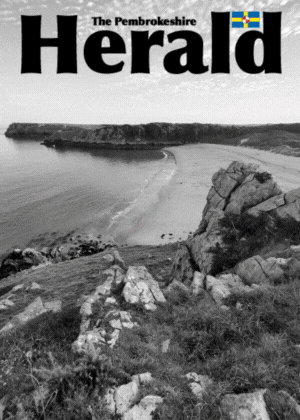News
Badger and the farewell to arms

 HELLO readers! Last week Badger chilled your spines and tickled your funny bones (he hopes) with the tale of the legendary lost testicles of Pembrokeshire County Council. Today is, however, a solemn day. Today, October 31, is the day that the County Council bids a fond ‘adieu” to the much-loved and respected foul-mouthed bully, Bryn Parry-Jones. Badger will miss Bryn, too, readers. As the punchline to the longest running joke in Pembrokeshire, Bryn (or as Badger likes to think of him, ‘The Brynster’) was a major contributor to Badger’s oeuvre over the last sixteen months.
HELLO readers! Last week Badger chilled your spines and tickled your funny bones (he hopes) with the tale of the legendary lost testicles of Pembrokeshire County Council. Today is, however, a solemn day. Today, October 31, is the day that the County Council bids a fond ‘adieu” to the much-loved and respected foul-mouthed bully, Bryn Parry-Jones. Badger will miss Bryn, too, readers. As the punchline to the longest running joke in Pembrokeshire, Bryn (or as Badger likes to think of him, ‘The Brynster’) was a major contributor to Badger’s oeuvre over the last sixteen months.
And after this All Hallow’s Eve, Bryn will be no more the gag of last resort. Fear not, however, Badger is not overly concerned: He is sure the activities of the IPPG’s own Secret Squirrel, Rob Summons, will provide him with plenty of material as he scurries around attempting to plug the leaks in the IPPG ship of state. Poor PC Summons, readers! As he desperately prowls the ether, spying on the IPPG’s ‘enemies’, his adventures into Facebook and the blogosphere will reveal that the regard in which he and his fellow IPPG toadies are held is even lower than even he might have suspected. An online poll on Facebook discovered that not a single IPPG member attracted a single public vote to be leader of the Council. East Williamston’s fearless blogonaut, Jacob Williams, came second in the poll. While that evil so and so Mike Stoddart also featured strongly.
One can only hope that the Burton representative’s bearing of bad news to Jamie Adams is met with more understanding than his counterpart’s in V for Vendetta. But how, Badger wonders, how will we commemorate Bryn? In the past, readers, rulers erected massive monuments to themselves to celebrate their lives and triumphs. One only has to look at the city of Rome – choc-a-bloc with monuments to emperors famous, notorious and obscure – for evidence of even the least distinguished leader’s desperate quest for monumentality. Nero built his golden palace, Trajan his column and Augustus (probably the greatest butcher of them all) built a monument to peace.
Now, readers, it is certain that the former Chief Executive of Pembrokeshire County Council exercised more untrammelled power than even the mighty Constantine the Great, but one would hesitate to put the scale of his achievements as on a par with even Otho of the Roman emperors. The giant golden statue astride a marble horse opposite County Hall is surely a non-starter. Still less likely is the eternal flame to be situated atop the homage to the Brandenburg Gate planned for the entrance to Fishguard Harbour. Perhaps even a memorial hot dog stand might be pitching it a little high, readers. Of course, the relevance of even the most splendid work of art fades from the memory.
The Mona Lisa’s position as the wife of a long-forgotten Florentine cloth merchant is not what makes her portrait famous. In a recent visit to mid-Wales, Badger visited the Welsh Museum of Modern Art. There, he realised that content without context can denude even the most striking painting or sculpture of meaning and significance. Just sticking a label on a daub and expecting it to resonate with its viewer is not enough. And so readers, Badger rejects the idea of a monument celebrating the sparse achievements and many flaws and failures of Bryn Parry- Jones.
There is a sense, after all readers that our reluctance to vote in local elections; our reluctance to stand as candidates; our reluctance to hold to account the ‘good old boys’ and ‘good old girls’ who treat their wards as fiefdoms, led to a situation in which Bryn could hold sway over our biddable, obedient and wilfully ignorant representatives. And through them over us. That must not happen again, readers. Badger hopes that there will never again be a situation where almost a quarter of councillors are elected because nobody else wants to get ten signatures and put themselves forward. Badger has an idea, readers. Badger has mentioned the way in which art and monuments change their meanings as time passes. The same applies to festivals. When Badger was younger, it was ‘Guy Fawkes Night’.
Every year, thousands – if not tens of thousands – of effigies are burned on a pyre. Among the general population, who remembers that it is an anti-Catholic festival? We annually incinerate representations of Guy Fawkes – the would be slaughterer of a king, the Lords and Commons assembled and a large number of Londoners – to ensure we never forget the threat to Britain posed by those of a Roman Catholic persuasion. Nobody thinks of anti-Catholic sentiment as they eat their burger and watch several hundred pounds worth of pyrotechnics streak into the night sky, a –fizzing and a-banging. Or if they do, they are a member of one of those little tin tabernacle churches which are the last redoubt of religious bigots.
So, readers: Combining the horror of Halloween and the explosive bangs and whizzes of Bonfire Night, we could have Bryn Night! Across Pembrokeshire, communities would banish the ghastly shades of Parry- Jones and his sinister little h e l p e r s H a l l a n d Lewis, to remind each other never to let such as he happen again. To add a little extra spice to the occasion a model of a Porsche Panamera could be ceremonially burnt atop a pyre made up of the electoral literature of IPPG councillors. Have a happy Bryn Night and remember, r e m e m b e r , readers!
Crime
Emergency bags rolled out to support domestic abuse victims across Dyfed-Powys

Thirty packs provide immediate help for families fleeing dangerous situations
A NEW initiative aimed at supporting victims of domestic abuse has seen thirty emergency bags distributed for use across the Dyfed-Powys Police area.
The bags, which contain essential items including toiletries, non-perishable snacks and emergency supplies, are designed to offer immediate practical support to individuals and families forced to flee abusive situations, often with little or nothing.
The scheme forms part of the Police and Crime Commissioner’s wider commitment to improving outcomes for victims and is being delivered in partnership with Dyfed-Powys Police and Dal i Godi, the commissioned Independent Domestic Violence Adviser (IDVA) service.
Dal i Godi provides specialist support to victims at high risk of serious harm, including safety planning and advocacy through the criminal justice process.
Police and Crime Commissioner Dafydd Llywelyn said the initiative was already proving its value.
“This is an incredible initiative that I’m proud to support,” he said. “It provides meaningful help to those experiencing trauma and reflects our ongoing work to put victims first.
“Within just a few days of the bags being distributed to the Dal i Godi service, one was given to a victim fleeing a domestic abuse situation, along with a children’s pack to support their young family. That shows just how essential this support can be and how quickly it can make a difference.”
Detective Chief Inspector Llyr Williams, from the Dyfed-Powys Police Vulnerability Hub, said the emergency bags could provide a vital lifeline at critical moments.
“These emergency bags offer support at some of the most difficult moments in a person’s life,” he said.
“The contents provide immediate comfort, dignity and practical help for those leaving their homes in crisis. While simple, they represent an important first step towards safety and recovery.
“We are proud to be working with partners across the Dyfed-Powys area to ensure this support reaches people when they need it most.”
Anyone experiencing domestic abuse, or concerned about someone else, is encouraged to seek help. In an emergency, call 999.
Domestic abuse can also be reported online via Dyfed-Powys Police.
Support services available include Victim Support Dyfed-Powys, which offers free and confidential help to anyone affected by crime, whether or not it has been reported, and Dal i Godi, which provides specialist IDVA support for high-risk victims.
The Live Fear Free Helpline offers 24-hour support for those experiencing domestic abuse or sexual violence across Wales.
If you or someone you know is a victim of domestic abuse, please consider reporting it. If you are in danger or need support right away, please call 999.
You can report domestic abuse through the online crime reporting service here: Report domestic abuse | Dyfed-Powys Police.
Support is also available via the below support services:
Victim Support Dyfed-Powys
Free, independent support for anyone affected by crime in the Dyfed-Powys area, whether or not it has been reported to the police.
0300 123 2996
Dal i Godi (IDVA Service)
Specialist support for victims of domestic abuse at high risk, offering safety planning, emotional support, and advocacy with agencies such as police and courts.
01267 221194
Live Fear Free Helpline
24/7 support for anyone experiencing domestic abuse or sexual violence.
0808 80 10 800 | Text 07860 077333
News
Welsh-language school praised for ‘happy, proud and friendly community’

Estyn highlights strong leadership, positive attitudes and a clear curriculum vision at Ysgol Bro Preseli
A WELSH-medium all-age school in Crymych has been praised by inspectors for fostering a “happy, proud and friendly community,” according to a recent Estyn report.
Inspectors said pupils at Ysgol Bro Preseli show pride in their local area, thrive both academically and socially, and are well prepared for the next stages of their learning.
The school currently has 932 pupils on roll, including 118 in the sixth form, and has operated as an all-age school since 2022.
Estyn found that most pupils demonstrate extremely positive attitudes to learning, treat staff with respect, and listen carefully to the contributions of their peers.
The report also notes that, in almost all cases, teachers show strong subject knowledge. Inspectors highlighted the close and supportive relationships staff build with pupils, alongside the creation of a safe learning environment where pupils are not afraid to make mistakes.
It states: “As a result of a clear strategic direction and detailed planning, teachers provide beneficial practical activities that allow pupils to develop purposeful oracy, reading and writing skills in language sessions and across the other areas of learning and experience.”
Inspectors also praised the school’s clear curriculum vision, rooted in its motto Gwreiddiau a Gorwelion (Roots and Horizons).
“Leaders and teachers provide a coherent curriculum and learning experiences that bridge the primary and secondary sectors effectively,” the report said. “Staff plan stimulating activities and experiences for pupils to learn and deepen their understanding within the areas of learning and experience. This contributes positively to the sense of belonging that permeates the whole curriculum of Ysgol Bro Preseli.”
Headteacher Rhonwen Morris said the report was a reflection of the collective effort across the school community.
“As a successful all-age Welsh-medium school, we are delighted that the report recognises our commitment to excellence and the unique identity that makes Ysgol Bro Preseli so special,” she said.
“Since becoming an all-age school in 2022, our cohesive leadership team and governing body have focused on building a strong foundation based on our values of Welsh ethos, kindness, community and responsibility.
“The report highlights the excellent strategic work of staff at all levels, which is a testament to the shared dedication and vision that drives our school forward.
“It is gratifying that the report reflects what we continuously aim to achieve day in and day out. This achievement belongs to our entire community — staff, pupils, parents and governors — and together we will continue to build on this success and provide the very best education for every pupil.”
Charity
Welsh opticians raise £1,600 for people experiencing homelessness

SPECSAVERS Pembroke Dock has helped raise £1,600 to support people experiencing homelessness this winter, with all funds going to The Wallich’s winter appeal.
Thirteen stores from North, South and West Wales donated £1 for every customer feedback form completed during November to help The Wallich, Wales’ largest homelessness and rough sleeping charity, continue its vital work.
Supporting more than 8,000 people experiencing or at risk of homelessness across the nation each year, The Wallich runs around 100 diverse projects across 20 local authorities to provide hope, support and solutions to end homelessness.
Funds raised by Specsavers will go directly to the Wallich’s Flexible Assistance Fund, which provides small but vital emergency grants. The grants support people at crucial turning points, helping cover essential costs such as phone credit, rent or food shops.
This initiative is a continuation of Specsavers’ wider homelessness programme, which sees over a hundred Specsavers stores and Home Visits services hold out-of-hours or pop-up clinics and invite people affected by forms of homelessness to use their services for free.
Specsavers’ North Wales regional relationship manager, Martin Lawrence, who helped organise the fundraiser, says: ‘We’re really proud to be supporting The Wallich’s winter appeal at a time when support is needed most.
‘Homelessness affects people in every community and as locally owned and run businesses, Specsavers stores are committed to raising awareness of the issue and supporting people through their toughest moments.
‘We’re excited to build on the success of this fundraiser and strengthen our partnership with The Wallich in the new year.’
Louisa Turner, head of fundraising at The Wallich, adds: ‘Winter can be an incredibly difficult time for people experiencing homelessness and this support from Specsavers will make a real difference.
‘The funds raised will help provide emergency grants at critical moments – whether that’s putting food on the table, helping someone stay connected with their loved ones or preventing someone from losing a safe place to live.
‘This kind of support creates vital turning points and helps people move towards a safer, more secure future.’
Specsavers works year-round with homelessness charities including Crisis, Vision Care and The Big Issue, to improve access to healthcare and advocate for policy change – ensuring people experiencing homelessness can receive free eye tests, glasses and hearing checks.
To find out more about Specsavers or to book an appointment at your local store, visit: https://www.specsavers.co.uk/stores.
-

 Crime3 days ago
Crime3 days agoMilford Haven man jailed after drunken attack on partner and police officers
-

 News6 days ago
News6 days agoDyfed-Powys Police launch major investigation after triple fatal crash
-

 Crime3 days ago
Crime3 days agoTeenager charged following rape allegation at Saundersfoot nightclub
-

 Crime4 days ago
Crime4 days agoMan charged with months of coercive control and assaults
-

 Crime4 days ago
Crime4 days agoMan sent to Crown Court over historic indecent assault allegations
-

 Crime6 days ago
Crime6 days agoMan spared jail after baseball bat incident in Milford Haven
-

 Crime4 days ago
Crime4 days agoMilford Haven man admits multiple offences after A477 incident
-

 Crime4 days ago
Crime4 days agoWoman ‘terrified in own home’ after ex breaches court order



















